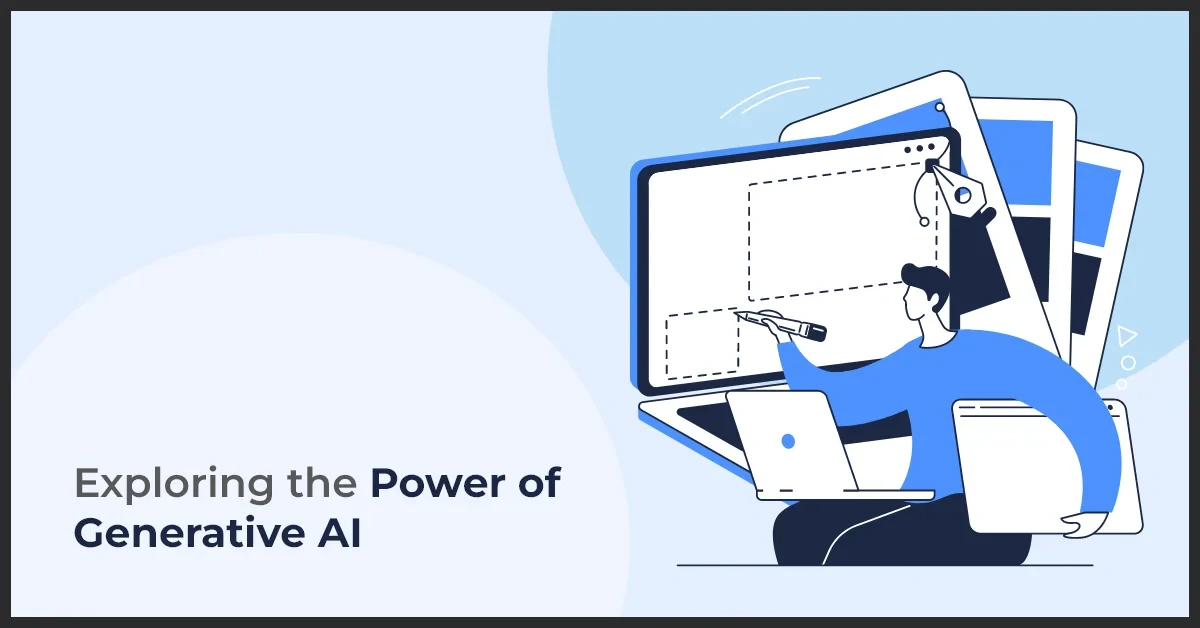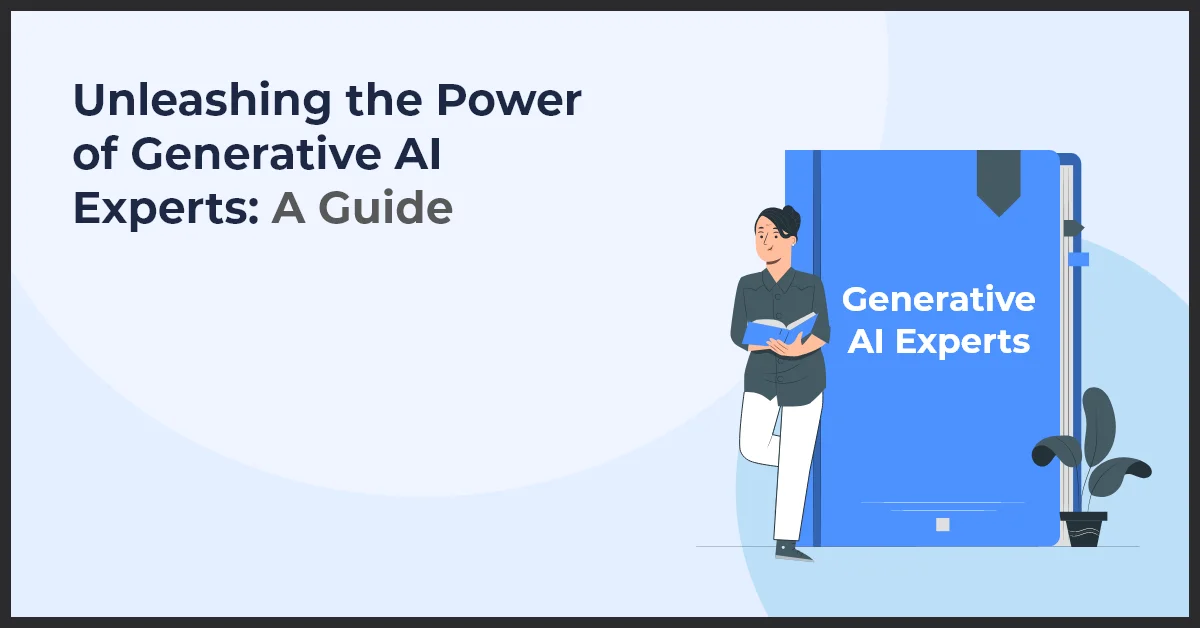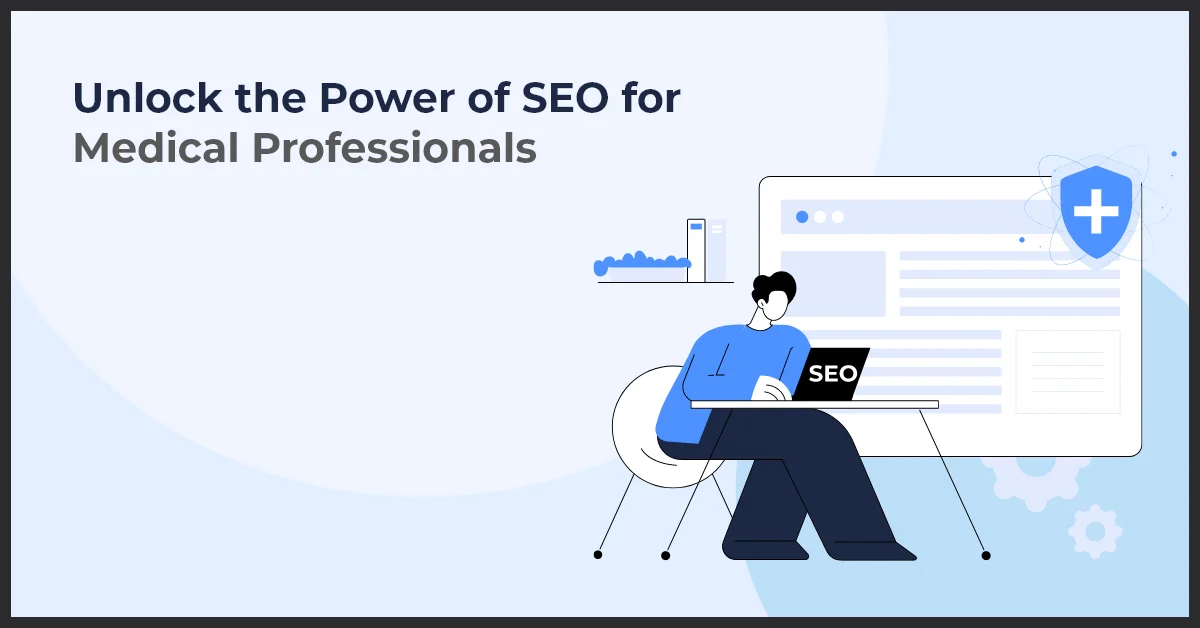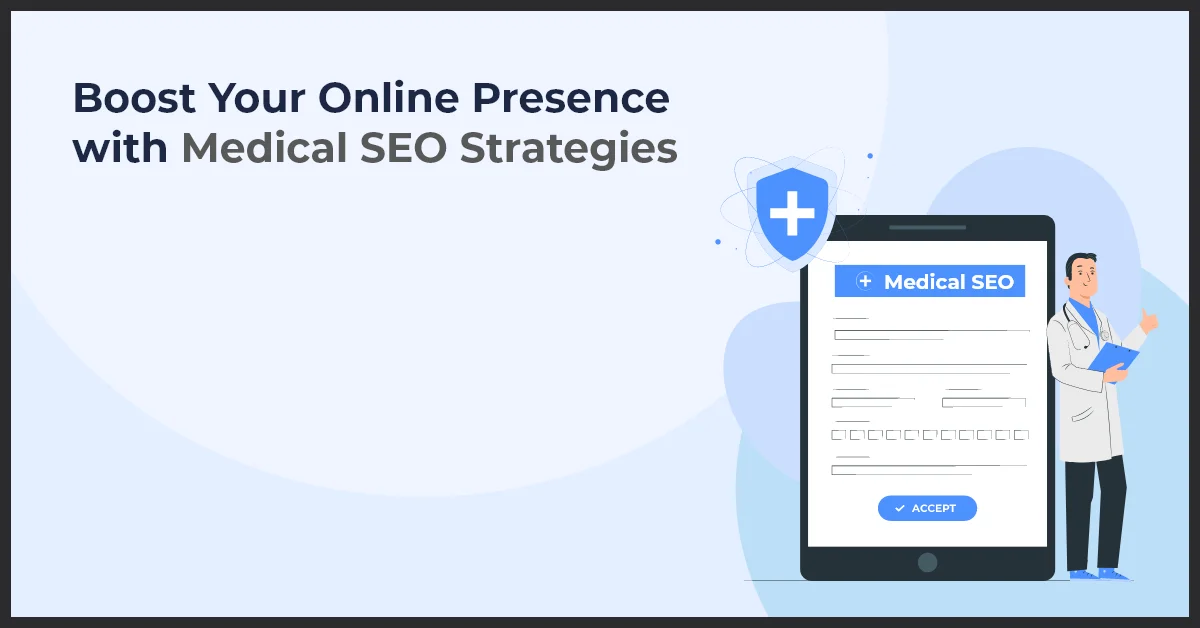Exploring the Power of Generative AI

Published on: August 1, 2023
Updated on: September 06, 2024
2013 Views
- Digital Marketing
22 min read
Significant advances in AI models like DALL-E 2, GPT-3, and Stable Diffusion have shown the vast creative potential of this technology. Gartner predicts that a major blockbuster film will be released by 2030, with 90% of the film generated by AI [1].
In other words, it is fair to expect generative AI to become even more powerful and ubiquitous. Yet, a parallel narrative of concern accompanies this technological marvel that questions the risks of intellectual property theft, the propagation of bias, and the potential displacement of human creativity.
So, what is in store for this game-changing technology? This blog explores all this and much more. But first:
What Is Generative AI?
Generative AI is a class of AI models designed to generate new data similar to the data used to train it. These models can create various outputs, such as text, images, music, or complex designs, making them highly versatile tools for creative and analytical tasks. They employ advanced machine learning techniques, like generative adversarial networks, autoencoders, and transformer models, to learn patterns in the data and generate original content.
Did you know?
The global Generative AI market size was US$10.6 billion in 2022 and is expected to accelerate at a CAGR of 31.4%, registering an incremental revenue of US$151.9 billion by 2032. [2]
Reasons for Generative AI's Popularity
Here are some key ways we may see generative AI make an impact in the upcoming years:
- More Realistic Media Synthesis
Tools like DALL-E 2 and Stable Diffusion can generate impressively realistic images from text prompts. However, there is still room for improvement in capturing fine details and logical coherence in generated media. New techniques may reduce artifacts and produce media that is indistinguishable from real photos and videos.
- Hyper-Personalized Content
As generative models incorporate more personal data and context, they can synthesize content tailored to individuals. AI assistants could generate personalized stories, products, or recommendations for you.
Brands could also tap into generative AI to provide customized marketing and experiences. Gartner predicts that 30% of outbound marketing messages from enterprises will be generated by AI by 2025, up from under 2% in 2022 [3].
- Next-Level Creativity and Discovery
Better generative models don't just mimic - they can unlock completely novel ideas. They could blend concepts in groundbreaking ways by analyzing connections in vast datasets to significantly augment human creativity in art, music, fashion, and product design while significantly improving productivity. This concurs with what most US adults, 62%, believe—AI in the workplace can save time; 47% say AI should replace redundant tasks to increase productivity [4].
- Smarter Decision-Making
Generative models have shown the ability to make reasonable predictions, inferences, and judgments. As their analytical capabilities grow, AI could help guide better decisions in complex domains like finance, medicine, and public policy. Of course, humans must provide oversight to ensure AI reasoning aligns with ethics and facts.
- More Accessible Content Creation
Already, generative AI is making creative skills more accessible to everyday users. Simple interfaces and prompts could allow anyone to synthesize quality content quickly. This democratization of creation could inspire broader participation in media production and knowledge sharing.
Advancements in Deep Learning for Generative AI
The field of Generative AI has witnessed significant advancements with the advent of deep learning techniques. These advancements have revolutionized the capabilities of generative AI algorithms, enabling them to generate increasingly realistic and creative outputs.
Deep Neural Networks and their Training Process
Deep learning plays a pivotal role in enhancing the power of generative AI. Deep neural networks, with their numerous layers and complex architectures, have the ability to learn from large datasets with high-dimensional features.
The training process involves feeding the neural network with a plethora of training examples and optimizing its parameters through backpropagation and gradient descent. This iterative process allows the model to refine its performance and generate outputs that closely resemble the input data.
Contribution to Enhancing Generative AI Capabilities
The advancements in deep learning have significantly contributed to enhancing the capabilities of generative AI. These advancements include:
- Improved Network Architectures: Researchers have developed novel network architectures, such as Generative Adversarial Networks (GANs) and Variational Autoencoders (VAEs), which enable more precise control over the generation process.
- Unsupervised Learning: Deep learning techniques allow generative AI models to learn from unlabelled data, enabling them to identify complex patterns and generate coherent outputs.
- Model Optimization: Advanced optimization algorithms, such as Adam, have improved the convergence speed and overall performance of generative AI models.
- Transfer Learning: Deep learning facilitates transfer learning, where pre-trained models on large datasets can be fine-tuned for specific generative tasks, saving significant computational resources.
- Enhanced Training Data: Deep learning allows for the utilization of massive amounts of data, facilitating more accurate modeling of complex dependencies and enhancing the diversity of generated outputs.
These advancements in deep learning techniques have propelled generative AI to new heights, empowering it to generate high-quality content, images, and creative outputs.
Language Generation with Generative AI
Language generation refers to the ability of a system to produce human-like text using natural language processing (NLP) techniques. With the emergence of generative AI, language generation has witnessed significant advancements and has transformed the way we interact with machines. Let's explore the various aspects of language generation with generative AI.
Natural Language Processing (NLP) Basics
To understand language generation with generative AI, it is essential to grasp the basics of natural language processing (NLP). NLP is a subfield of AI that focuses on the interaction between humans and computers through natural language. It involves tasks such as speech recognition, language understanding, and language generation.
NLP allows generative AI models to understand and process human language, enabling them to generate coherent and contextually appropriate responses. Through NLP, generative AI systems can analyze and interpret text data, extract relevant information, and generate meaningful and contextually relevant text.
Generative AI's Impact on Language Generation
Generative AI has revolutionized language generation by enhancing the capabilities of NLP models. Traditional language generation models relied on predefined rules and templates, limiting their ability to produce diverse and contextually relevant text.
With generative AI, language generation models can learn from massive amounts of data and generate human-like text that adheres to the context and style of the input. Generative AI models, such as GPT-3 (Generative Pre-trained Transformer 3), have achieved impressive results in various language generation tasks, including text completion, dialogue generation, and even creative writing.
Chatbots and Text Summarization with Generative AI
Generative AI has greatly influenced the development of chatbots, enabling them to provide more human-like and natural conversations. By training chatbot models on vast amounts of conversational data, generative AI allows chatbots to understand context, generate appropriate responses, and even exhibit conversational quirks.
Additionally, generative AI has also revolutionized text summarization. Previously, text summarization relied on extractive methods that involved selecting and combining parts of the original text. However, generative AI models can generate concise and coherent summaries by understanding the content and generating new text that captures the essence of the original text.
Image Generation using Generative AI
Generative AI has revolutionized the way we create and manipulate images. With the power of generative AI, it is now possible to generate realistic images that were previously unimaginable. This breakthrough technology has opened up new possibilities for various industries.
Noteworthy Results in Generating Realistic Images
Generative AI algorithms have achieved remarkable results in generating highly realistic images. By training on vast datasets, these algorithms learn to understand the underlying patterns and characteristics of images, enabling them to produce visually impressive outputs. Whether it's generating lifelike portraits or creating stunning landscapes, the power of generative AI is evident in the quality and realism of the generated images.
Introduction of GANs (Generative Adversarial Networks)
One of the most influential techniques in image generation using generative AI is the concept of Generative Adversarial Networks (GANs). GANs consist of two neural networks: the generator and the discriminator. The generator is responsible for creating new images, while the discriminator evaluates the generated images for authenticity. Through an iterative process of training, the generator learns to produce images that are increasingly difficult for the discriminator to distinguish from real images.
Applications in Creating Convincing Visuals
The applications of generative AI in creating convincing visuals are vast. From generating realistic faces for video game characters to creating unique designs for fashion, generative AI has become an invaluable tool for designers and artists. Additionally, it has found applications in the film industry, where it allows for the creation of breathtaking visual effects and realistic virtual environments. The power of generative AI in image generation empowers creatives to unleash their imagination and bring their ideas to life.
Industry Applications of Generative AI
Generative AI has the potential to revolutionize various industries and drive innovation to new heights. Let's explore some of the exciting applications of generative AI in different sectors:
Virtual Character Creation
Generative AI can be used to create realistic virtual characters for video games, movies, and virtual reality experiences. By leveraging generative models, developers can design unique characters with diverse appearances, personalities, and behaviors, enhancing immersion and storytelling in digital entertainment.
Product Design and Development
Generative AI enables product designers to explore countless design iterations quickly and efficiently. By inputting constraints and desired parameters, generative models can generate innovative designs, accelerating the prototyping and iteration stages of product development. This empowers designers to create optimized, functional, and aesthetically appealing products.
Synthetic Data Generation for Training Models
Generative AI can generate synthetic data that mimics real-world data, helping to augment limited datasets and address privacy concerns. With generative models, organizations can create synthetic data for training machine learning models, enabling them to achieve better performance and generalization in various domains, such as computer vision, natural language processing, and predictive analytics.
Enhanced Graphics and Visuals
Generative AI amplifies the capabilities of graphics and visual design by automatically generating high-quality images, animations, and visual effects. Whether it's creating realistic textures, adding visual enhancements, or generating novel designs, generative models empower artists and designers to push the boundaries of visual creativity in fields like advertising, digital media, and animation.
Impact on Drug Discovery
Generative AI shows tremendous promise in accelerating drug discovery processes. By leveraging generative models, researchers can design and generate novel molecules with desired properties. This enables faster identification of potential drug candidates, reducing costs and time required for traditional trial-and-error approaches. Generative AI offers opportunities for more efficient and targeted drug design and development.
Data Efficiency and Representation Learning in Generative AI
Data efficiency plays a crucial role in the success of generative AI. With limited labeled data available, it is imperative for generative AI models to make the most efficient use of their data. Generative AI can generate new instances by leveraging advanced techniques while preserving important underlying representations.
Efficient Utilization of Data by Generative AI
In the realm of generative AI, making the most of available data is essential. Traditional machine learning models often require vast amounts of labeled data to achieve satisfactory results. However, generative AI models have the remarkable ability to learn from relatively small datasets.
Through techniques like transfer learning and data augmentation, generative AI can effectively leverage existing labeled datasets, even if they are limited in size. By incorporating knowledge from pre-trained models, generative AI can generalize and learn new concepts from a fraction of the data required by traditional approaches.
Learning Underlying Representations for Generating New Instances
Representation learning is a fundamental aspect of generative AI. It involves capturing the essential characteristics and features of the data to generate new instances that are both coherent and meaningful. Through representation learning, generative AI models can uncover latent variables and structures within the data, enabling them to generate novel and diverse outputs.
Generative AI models use techniques like variational autoencoders (VAEs) and generative adversarial networks (GANs) to learn useful representations. VAEs focus on reconstructing the input data while simultaneously learning a latent space that captures its underlying structure. GANs, on the other hand, pit a generator against a discriminator, encouraging the generator to produce data indistinguishable from real examples.
Overlaps with the Power of Generative AI Discussion
The concepts of data efficiency and representation learning are interconnected with the power of generative AI. The ability to generate new instances from limited data and learn underlying representations contributes to the overall power and versatility of generative AI. By harnessing these capabilities, generative AI can produce realistic images, generate coherent text, and even create impressive artwork.
Furthermore, data efficiency and representation learning also address some of the ethical concerns associated with generative AI. With the ability to generate meaningful instances from limited labeled data, the reliance on potentially biased or unethical datasets can be reduced.
Popular Generative AI Use Cases
Gartner predicts that generative AI will soon account for 10% of all data produced, rising from less than 1% currently [5]. This rapid expansion is attributable to its innovative applications across various domains: visual content, audio, text, and code.
- Visual Content Generation
Image Creation and Refinement: Generative AI tools adept in image creation often employ text-to-image tactics. Users can prompt the AI with text, which the tool uses to generate realistic images accordingly. They can produce 3D models or original artwork, and AI tools also excel in refining existing pictures. They can complete incomplete images, translate a semantic image into a photorealistic one, alter an existing image, or even enhance its resolution.
Video Production: Generative AI streamlines video production by automating laborious tasks such as video composition, adding special effects, and animation. These tools can create videos from scratch, manipulate videos, enhance video resolution, predict future video frames, and transfer styles from one video to another.
3D Modeling: Generative AI can construct 3D shapes and models using VAEs, GANs, autoregressive models, or neural implicit fields. They are beneficial in 3D-based tasks like 3D printing, 3D scanning, and virtual reality.
- Generative AI in Audio Production
Music Composition: Generative AI can be instrumental in producing new music compositions by learning patterns and styles from input music. They can generate fresh music for ads or creative purposes despite potential copyright infringement issues.
Text-to-Speech (TTS) Generators: TTS generators, typically GAN-based, can convert written text into realistic speech audio. They utilize extensive speech and text data to train machine learning models and generate high-quality speech from text.
Speech-to-Speech (STS) Conversion: Using STS conversion, generative AI can produce new voices using existing audio files, making it a boon for the gaming and film industry for creating voiceovers.
- Text Generation Through Generative AI
Text-generative AI platforms like ChatGPT are gaining popularity for their proficiency in producing content such as articles, blog posts, dialogues, language translations, text completions, and more. They utilize Natural Language Processing (NLP) and Natural Language Understanding (NLU) techniques to comprehend a text prompt and generate intelligent responses. These tools benefit creative writing, developing conversational agents, language translations, and generating marketing and advertising content.
- Generative AI in Code Generation
Generative AI simplifies software development by automatically generating code, reducing developers' time and effort on coding, testing, and bug fixing. These models can complete a code snippet, convert a text prompt into codes, create test cases, fix bugs, and integrate machine learning models into the software.
Now that you know some popular use cases of Generative AI, how do you apply it to your business? Here is how Generative AI can be used across different departments—from sales and marketing to product, R&D, and finance.
Marketing:
- Create dynamic ad copy and landing pages
- Generate detailed customer personas and insights
- Automate email campaigns and social media posts
- Synthesize new product descriptions and branding assets
Sales:
- Generate sales collateral like presentations and one-pagers
- Analyze customer data to predict churn and identify upsell opportunities
- Automate lead follow-ups and customize pitches
- Summarize calls and meetings to capture key details
HR:
- Source and screen resumes more efficiently
- Automate interview scheduling and follow-ups
- Generate job descriptions free from bias
- Create personalized onboarding checklists for new hires
Product:
- Rapidly prototype and iterate on new product concepts
- Forecast demand and optimize pricing strategies
- Automate support tasks like FAQ bots and documentation
- Analyze customer feedback and reviews
R&D:
- Accelerate literature reviews and data analysis
- Hypothesize and simulate novel materials or drug compounds
- Optimize manufacturing and supply chain processes
Finance:
- Generate accurate demand forecasts and optimize inventory
- Analyze past performance to predict future trends
- Automate invoice processing and bookkeeping
- Create customized reports and visualizations
5 Must-Have Generative AI Tools
- DALL-E 2
DALL-E 2 is an AI system created by OpenAI that can generate realistic images and art from text descriptions. It is trained on vast image datasets and uses a deep neural network to understand relationships between pictures and natural language. DALL-E 2 can create original images that don't directly copy from its training data.
DALL-E 2 can:
- Generate photorealistic photos from prompts like "a penguin wearing sunglasses on the beach."
- Create original logo designs based on a business name and description
- Produce surrealistic digital art by combining disparate objects in novel ways
Key features include control over image styles, sizes, and levels of detail. Users can also edit images by adding or modifying text prompts.
- ChatGPT
ChatGPT is an AI chatbot built by OpenAI using a natural language processing technique called transformer neural networks. It understands conversational prompts and provides human-like responses on nearly any topic.
Key features of ChatGPT include:
- Carrying out intelligent, context-aware dialogues
- Answering follow-up questions
- Admitting knowledge gaps if asked something it doesn't know
- Refusing inappropriate requests
- Summarizing conversations and information
ChatGPT can explain concepts, generate content, provide advice, and complete many other language tasks. As more users interact with the system, it continues to improve through machine learning techniques.
- Jasper
Jasper is an AI writing assistant created by Anthropic to generate original long-form content.
Jasper can:
- Write blog posts, articles, essays, fiction, and other formats based on a prompt.
- Revise and expand on an existing draft
- Provide creative ideas while avoiding plagiarism
- Follow customizable style, tone, and formatting guidelines
- Cite sources appropriately when asked
Jasper aims to augment human writing rather than replace authors. Its capabilities make content creation much faster and easier.
- Lex
Lex is an anthropic natural language summarization tool that condenses texts while retaining essential information.
Lex's main features include:
- Generating summaries of articles, reports, legal documents, scientific papers, and other long-form content
- Customizing summary length from brief overviews to comprehensive summaries
- Handling complex narratives, diverse vocabulary, and nuanced details
- Preserving logical structure and important points from the original text
- Allowing developers to integrate summarization into other applications
Lex aims to save time on research and information consumption. Users can get the essence of lengthy documents without reading them fully.
- GitHub Copilot
GitHub Copilot is an AI pair programmer created by GitHub based on OpenAI Codex. It suggests complete lines of code and functions in real-time as developers write programs.
Copilot can:
- Autocomplete boilerplate code and mundane coding tasks
- Recommend alternative ways to approach problems
- Identify and fix bugs by suggesting fixes
- Generate tests and documentation based on comments
- Translate comments into code
- Suggest context-relevant functions and libraries
Copilot learns to produce helpful, syntactically correct code to boost productivity by continuously analyzing public code repositories along with programmer input.
Navigating the Ethical Landscape of AI
According to research for the State of AI in the Enterprise, 5th Edition, 94% of respondents say AI is critical to business success, 82% say AI increases job satisfaction, but 47% say AI is a concern [6]. As AI increasingly integrates into healthcare, finance, law enforcement, and recruitment, businesses must thoughtfully assess and address the ethical implications. Here are some key factors to keep in mind
- Transparency in AI Systems
A core ethical priority is promoting transparency in AI systems. When AI is used to make high-stakes decisions—like credit approval or criminal sentencing—it is crucial that the algorithms are interpretable and explanations available. "Black box" systems that can't explain their reasoning create accountability problems. Expect more transparent AI models, data, and processes in the future to improve trust.
- Mitigating Unconscious Bias
AI systems reflect the biases—gender, race, age, and more—of the limited human developers and data used to train them. This can propagate harmful discrimination through automated decisions. Teams building AI will proactively identify and mitigate sources of unfair bias. Techniques like regularization, cross-validation, and synthetic data generation can improve model fairness.
- Protecting Privacy Rights
AI often relies on massive datasets – including people's sensitive personal information. Collecting and using such data poses ethical challenges. Most workers, 82%, are concerned about hackers using generative AI to create scam emails [7]. Systems must ensure consent, anonymization, data security, and proper retention periods. Both companies employing AI and individuals contributing data deserve clear privacy safeguards.
- Developing Safety Standards
As AI takes on real-world tasks, ensuring systems behave safely and reliably is imperative – self-driving cars are a prime example. When asked about the challenges they face implementing generative AI, business leaders consistently cited concerns over data security as a top concern [8]. Industry standards are coming up that mandate rigorous testing, simulation of edge cases, human oversight protocols, and other precautions integrating AI where mistakes could prove costly.
- Promoting Accountability
Defective AI can cause harm, just like any faulty product. However, legal liability frameworks are still catching up to governing AI responsibly. As AI becomes more autonomous, corporations must have processes ensuring human accountability across the AI lifecycle. External audits, risk assessments, and reporting requirements should counter the diffusion of responsibility.
By pondering AI ethics early and often, we can align powerful innovations with human rights and shared prosperity. With wise governance, AI can elevate society. The public and private sectors play key roles in equitably developing AI for all.
Future Possibilities and Limitations of Generative AI
Generative AI has the potential to revolutionize various industries and contribute to technological advancements in the future. Let's explore some of the exciting possibilities and limitations of this cutting-edge technology.
Potential of Generative AI in Healthcare, Entertainment, Autonomous Systems, and Research
Generative AI holds immense promise in the healthcare industry. With its ability to create realistic medical images and simulate disease progression, it can aid in diagnosis, treatment planning, and medical research. It has the potential to accelerate drug discovery processes and personalize patient care.
In the entertainment industry, generative AI can be leveraged to create lifelike characters, landscapes, and special effects. This technology can enhance the gaming experience by generating unique game environments, non-player characters, and dynamic storylines. It can also be used in filmmaking and animation to streamline the production process and bring creative visions to life.
Autonomous systems can greatly benefit from generative AI. By generating highly realistic scenarios, it can aid in training self-driving cars, drones, and robots. Generative AI can play a crucial role in improving the safety and efficiency of autonomous systems by simulating various real-world scenarios and enabling them to make informed decisions.
In the field of research, generative AI can assist scientists in generating new hypotheses, designing experiments, and analyzing complex data. This technology has the potential to accelerate scientific discoveries and facilitate breakthroughs in various domains, such as chemistry, physics, and genomics.
Identifying Challenges and Limitations in its Application
While generative AI holds great promise, several challenges and limitations need to be addressed. One of the key challenges is the ethical use of generative AI. As this technology becomes more advanced, there is a need to establish guidelines and regulations to ensure it is used responsibly and ethically.
Another limitation is the requirement for large amounts of high-quality training data. Generative AI models heavily rely on extensive datasets for training, which may not always be readily available or have ethical implications. Finding solutions to generate representative and unbiased training data is crucial for the widespread adoption of generative AI.
Generative AI models can also suffer from issues of interpretability and explainability. Understanding how and why a model produces certain outputs is important for gaining trust, ensuring reliability, and detecting potential biases or errors. Progress in developing transparent and interpretable generative AI models is necessary to mitigate these concerns.
Moreover, cybersecurity threats associated with generative AI must not be underestimated. Adversarial attacks can exploit vulnerabilities in these models, leading to the generation of malicious or misleading content. Robust defenses and detection mechanisms should be developed to safeguard against the potential misuse of generative AI technology.
In conclusion, while generative AI presents exciting possibilities, it is crucial to address its ethical, technical, and cybersecurity challenges. By doing so, we can harness its potential to revolutionize various industries, improve human lives, and drive innovation in the future.
Conclusion
Looking toward the future, ongoing developments in Generative AI promise even greater capabilities and advancements. As the technology matures, we can expect more sophisticated algorithms and models that will further enhance the creative possibilities and applications of Generative AI.
However, as with any powerful technology, there are ethical and societal implications that must be considered. The potential misuse or malicious use of Generative AI raises concerns about the authenticity and reliability of information, as well as issues surrounding privacy and ownership of generated content.
In conclusion, Generative AI holds immense potential to transform various industries and creative fields, offering new avenues for innovation, efficiency, and artistic expression. As ongoing developments continue to shape the landscape of Generative AI, it is crucial to approach its implementation with a thoughtful and ethical mindset, considering the broader implications and ensuring that it is utilized in a responsible manner.
To learn more about how to leverage generative AI to transform your business, contact the experts at Growth Natives by calling +1 855-693-4769 or emailing us at info@growthnatives.com.
Sources:
- https://www.gartner.com/en/articles/beyond-chatgpt-the-future-of-generative-ai-for-enterprises
- https://finance.yahoo.com/news/generative-ai-market-observes-strong-073600486.html?
- https://www.gartner.com/en/articles/beyond-chatgpt-the-future-of-generative-ai-for-enterprises
- https://www.insiderintelligence.com/content/generative-ai-provokes-mixed-feelings-written-content
- https://www.gartner.com/en/newsroom/press-releases/2021-10-18-gartner-identifies-the-top-strategic-technology-trends-for-2022
- https://www2.deloitte.com/us/en/pages/consulting/articles/state-of-ai-2022.html
- https://www.itpro.com/technology/artificial-intelligence-ai/370366/social-engineering-attacks-generative-ai-soar-135
- https://www.salesforce.com/news/stories/generative-ai-research/
- https://www.analyticsinsight.net/beyond-chatgpt-what-is-the-future-of-generative-ai-for-enterprises/



